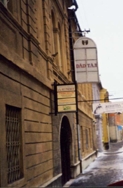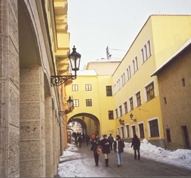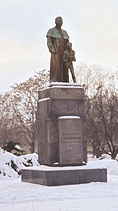Since the re-emergence of the Rusyn identity began in Central Europe in the late 1980s, it has been the Rusyns of first Czechoslovakia, and then after 1993 Slovakia, who have led the charge. In Slovakia, there are officially about 17,000 Rusyns, though some believe the true number to be as high as 120,000. They live primarily in the eastern part of the country, centered on Slovakia's third-largest city, Prešov (in Rusyn, Prjašov).
Beginning in the 1950s, Rusyns were officially considered to be either Ukrainians or a branch of the Ukrainian nation. The politically-motivated move virtually extinguished the Rusyn identity throughout Central Europe (except in non-aligned Yugoslavia, where the Rusyn identity flourished) until 1989 and the fall of Communism. In Slovakia today, the Rusyns are generally considered a fully separate nation from the Ukrainians, though nearly fifty years of Ukrainization has left much confusion.
"The Warhol Nation"
One of the reasons the Rusyn movement in Slovakia has been so successful is the fact that from the beginning, it has claimed an internationally renowned spokesman in the person of Andy Warhol (born Warhola). Warhol was born in Pittsburgh, Pennsylvania, in the United States, but came from Rusyn stock from a village near Medzilaborce (Rusyn, Medžilabirci) in present-day Slovakia. In fact, Warhol's first language was not English but Rusyn.
The Slovak Rusyns have capitalized on Warhol's celebrity from the earliest days of their movement. One of the first Rusyn organizations to be founded in Czechoslovakia was the Andy Warhol Society, in 1991. That same year, the Warhol Museum of Modern Art opened its doors in Medzilaborce. The museum draws more than 10,000 visitors annually.
As Tom Trier, a Danish filmmaker whose documentary The Warhol Nation takes on the issue of Rusyn identity, told the Pittsburgh Post-Gazette, Warhol has "become the number one activist for the Rusyn nationalist cause."
Off to a good start
The Rusyn movement in Slovakia began in December 1989 with the Manifesto of the Carpatho-Rusyns in Czechoslovakia, which listed the movement's initial goals as: the official recognition of the Rusyn national identity; the (re)introduction of the Rusyn language into schools; the re-establishment of the Greek Catholic Church; and the reorientation of the magazine Nove Zhyttija from Ukrainian identity to Rusyn.
Three months later, in March 1990, an organization called Rusyn'ska Obroda (Rusyn Renaissance) was founded and quickly became the primary agitator for the Rusyns' goals within Slovakia. Rusyn'ska Obroda scored its first major victory when the government agreed to allow "Carpatho-Rusyn" (together with Ukrainian) as a national category on the 1991 census.
Balkanization of eastern Slovakia?
The results of the census clearly showed that the Rusyn movement had taken off in a major way after little more than two years: almost 17,000 people declared themselves Rusyns and nearly 50,000 declared Rusyn their mother tongue. Meanwhile, only 14,000 declared themselves Ukrainian.
Though many believe that this led a single population (originally Rusyn, then 1950-1989 Ukrainian) to split into two separate groups (Rusyns and Ukrainians), census data seems to indicate something else entirely. Of the 50,000 who claimed Rusyn as their mother tongue, only about 3000 claimed Ukrainian nationality.
The majority of those who claimed Rusyn as their mother tongue actually claimed Slovak nationality. The reason for this is that when the Rusyns were officially reclassified as Ukrainians, large numbers of them underwent voluntary Slovakization, aligning themselves with the majority population instead. It would appear that while the "new" Rusyn population is partially composed of those who formerly were counted as Ukrainians, it is primarily made up of those who were formerly counted as Slovaks.
Spectacular successes
In any case, the census provided the government with statistical data that proved the existence of a Rusyn minority in Slovakia. The government subsequently began providing subsidies to Rusyn-minority organizations and in cultural pursuits.
Rusyn'ska Obroda took advantage of the new funding, and used it to publish a biweekly newspaper Narodny Novynky and a quarterly magazine Rusyn, which remain the two most important publications of the Rusyn movement in Slovakia.
 |
| the Aleksander Duknovyč Theatre in Prešov, the national theatre of the Rusyn minority in Slovakia |
In 1991, Medzilaborce played host to Rusyns from around the world, during the First World Congress of Rusyns. More than 300 people attended the now biennial event, which brings together the leaders of Rusyn movements throughout Central Europe, as well as supporters from such diverse places as Latvia, Russia, the United States, Canada and Germany.
The most significant achievement of the Rusyn movement after the 1991 census was the official codification of the Rusyn language. The process of codification began in 1992, with the First Congress of the Rusyn Language.
In 1993, the Institute of Rusyn Language and Culture was established in Prešov to carry on the work of codification. On 27 January 1995, Rusyn leaders, representatives of the Slovak government and others formally announced that the codification was complete, and the new literary language had become the official language of the Rusyn minority in Slovakia.
The newly codified language was soon after introduced into primary schools in parts of eastern Slovakia, and in 1998, a Faculty of Rusyn Language was opened at Prešov University's Department of National and Foreign Languages. The fact that the number of students enrolled in Rusyn classes at both the primary and secondary level has increased annually since their introduction attests to the attraction of the Rusyn movement to young people.
A stillborn language?
On 12 December 2000, the Slovak Spectator published an article, however, which seems to show that the Rusyn movement is not moving along nearly as quickly, or taking root nearly as deeply, as the events of the past decade seem to indicate. The article, subsequently republished in Transitions On-Line, tackled the question of just how much Rusyns in eastern Slovakia are using and promoting their language, and came up with a dim picture.
 |
| street scene in the old part of Prešov |
Ultimately, the article's author decides that the Rusyn language is not sufficiently practical, and that even while it is possible to maintain Rusyn culture and identity without the language, today's Rusyns want to be Europeans more so than Rusyns.
"[The] future of the Rusyn language and its culture in Slovakia as a distinct phenomenon remains, at best, uncertain," he ominously concludes.
An ongoing struggle
While some may see or predict decline for the Rusyn movement in Slovakia, the struggle continues on. In the mid 1990s, changes in the government affected most of Slovakia, and meant stricter policies and less funding for minorities, including the Rusyns. But the majority of the problems were short-lived, and today the movement is back on track.
Among the issues now on the agenda of Rusyn leaders is that of Rusyn-language radio programming. National minorities are guaranteed radio programming in their languages by the Slovak constitution, and the Rusyns are the only group which does not enjoy this right in practice. Though the government generally observes the distinction between Rusyns and Ukrainians, in this instance it maintains that mixed Ukrainian- and Rusyn-language programming is sufficient for both groups.
The battle for separate Rusyn-language programming began eleven years ago, and only now does it seem to be nearing a conclusion. On 10 January, the parliamentary Committee on Culture and the Media formally recommended that the director of Slovak Radio resolve the issue of Rusyn-language programming as soon as possible. Indeed, a job vacancy has been announced, though as of yet it is unfilled.
Rusyn'ska Obroda is keeping close tabs on Slovak Radio's progress. Immediately after the Committee made its recommendation to Slovak Radio, the Rusyns made their own: follow the recommendation and resolve the issue, or else we will take the case to international organizations. Virtually every issue of Narodny Novynky since that time has prominently featured updates on the status of Rusyn-language radio programming.
Another issue at the top of the Rusyn leaders' agenda is that of the Rus'kyj Dom (Rusyn House) building on the main square in Prešov. Founded in 1923, Rus'kyj Dom was the central cultural center of the Rusyns in Slovakia in the inter-war period. In 1965, the building was nationalized and became the property of the municipal authorities.
The building is now up for denationalization, but it is hotly contested between the Rusyn and Ukrainian communities. When the Rusyns were officially reclassified as Ukrainians, the building was used by Ukrainian-oriented groups, and so this is yet another issue where the Rusyn-Ukrainian confusion is compounding already complex problems.
In order to forward their claim, Ukrainian leaders formed an organization called Rus'kyj Klub in 1992. Soon after, the Rusyns did likewise with an organization called Authentic Rus'kyj Klub-1923. The two groups, surrounded by supporters, have been fighting it out in court and in the press ever since.
So far, courts in Prešov and Košice have decided that the Ukrainian organization cannot claim to be the legal successor of the original owners of the Rus'kyj Dom building. There has been no ruling as to the legitimacy of the Rusyn group.
On 19 January, the local authorities of Prešov called a meeting on the building and invited representatives of the Union of Rusyn-Ukrainians of Slovakia (Ukrainian community) and Authentic Rus'kyj Klub-1923 and Rusyn'ska Obroda (Rusyn community). While the very fact that the meeting was held is a sign of progress, the only decision was that the Regional Court in Prešov will have to decide whether the building will be returned to the Ukrainians or to the Rusyns. The date of that decision is still unknown.
Make or break
The date 26 May could very well go down in Rusyn history as either a day of national triumph or of national extinction. That is the day that the 2001 Slovak census is scheduled to begin.
Almost 17,000 people declared themselves Rusyns on the 1991 census just two years into the Rusyn movement. Considering that the prior census did not register a single Rusyn, this represents a major feat.
The 2001 census will be a benchmark for the Rusyn movement by clearly showing the level of support

|




